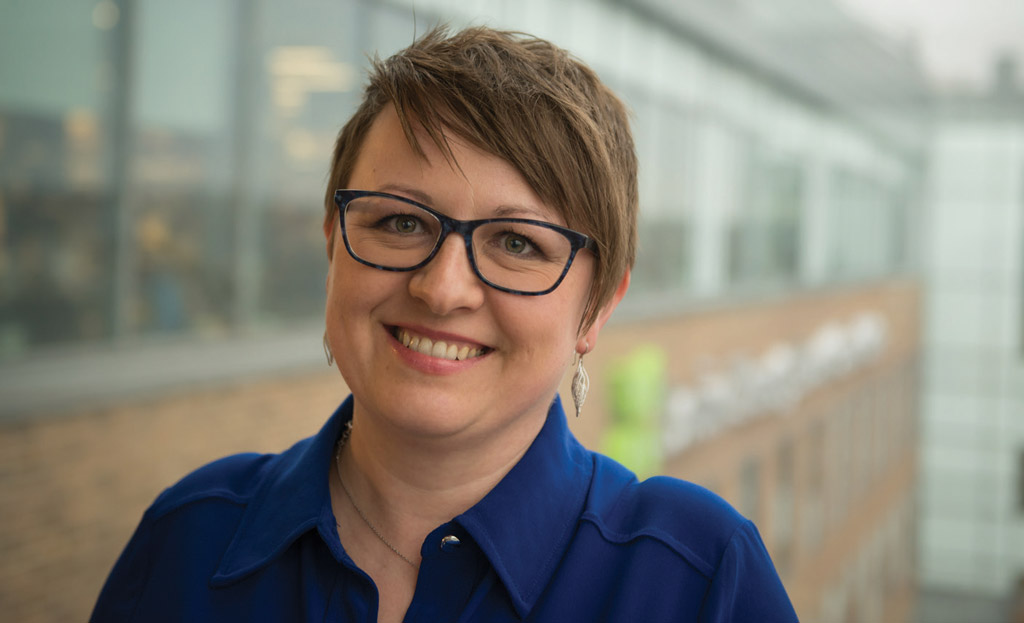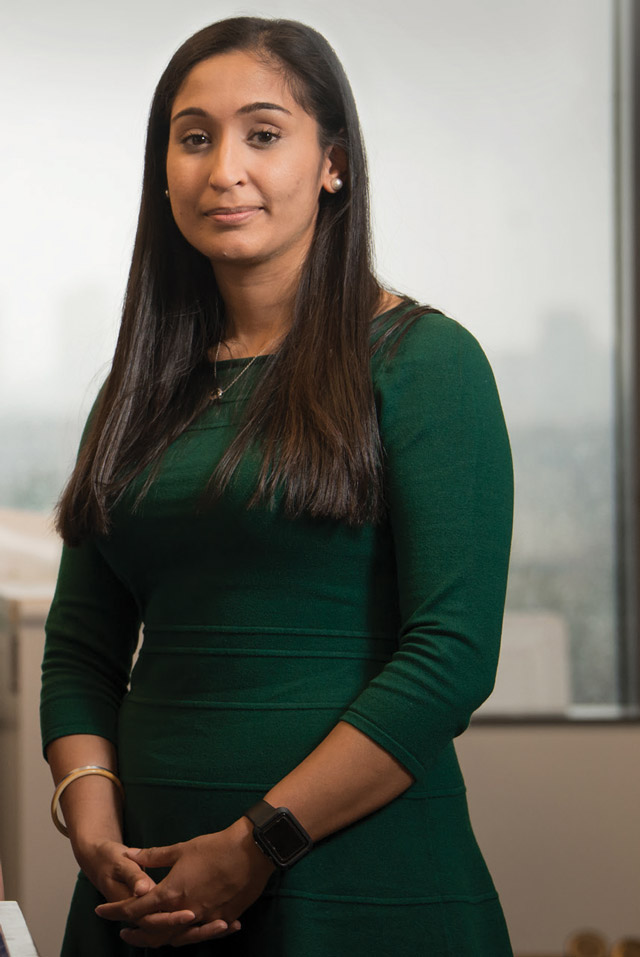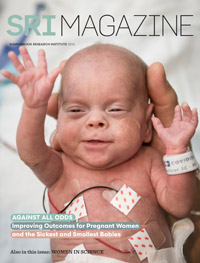Their way

With PhDs in hand, two SRI alumni chart custom-fitted courses

Dr. Patrycja Thompson, who did her PhD training at Sunnybrook Research Institute, has found satisfaction outside of the lab at the Centre for Commercialization of Regenerative Medicine, where she evaluates new cell- and gene-based technologies.
Photo: Kevin Van Paassen
Dr. Patrycja Thompson is used to asking why. As a child in Poland, she accompanied her mother to her job as director of a hospital lab. Once there, she’d plead with scientists to show her the magic to be found in a microscope’s lens and explain why the slide was being evaluated. Her inextinguishable curiosity was instinctive, so it’s unsurprising she gravitated toward an undergraduate degree in biology, followed by a PhD and postdoctoral fellowship in immunology.
Today, however, the question of why is directed at her. Seated in a lounge within Toronto’s bright—figuratively and literally—MaRS Centre, which is so abuzz with creative ideation one can almost hear the hum, the question is posed: why did you quit academia?
Now the manager of technology sourcing and evaluation at the Centre for Commercialization of Regenerative Medicine (CCRM), located in Toronto’s MaRS Centre, Thompson draws on three reasons in her response. The first pertains to family. As a woman in the field, she was aware of the compromise she was expected to make. She says, “I was told this by female scientists: ‘You have to choose between being a scientist and having a family.’” Now the mother of a five-year-old son, she adds, “I thought it was completely ridiculous. Why should that be a choice I have to make?” Her goal was to have a successful career as a scientist and a family.
It became apparent to Thompson that supporting a family on a “ridiculously low wage,” which she says she would have had for at least five years before possibly securing an academic position, was a heavy burden. Under the supervision of Dr. Juan Carlos Zúñiga-Pflücker, a senior scientist at Sunnybrook Research Institute (SRI) and the chair of immunology at the University of Toronto, Thompson explored the development of T cells en route to earning her PhD in 2015. Essential for immunity, T cells are white blood cells. They recognize and target invaders in the human body, including viruses and bacteria, and have become central to modern cancer treatments. After her PhD, Thompson relocated to Philadelphia, where she was a postdoctoral fellow. This was when she felt another push to leave academia, as she began thinking about the money she was making—or rather, not making. “At one point I said to myself, ‘It’s time I start valuing myself and my own abilities,’” she says. “Getting a PhD is a big deal; it’s almost as high in education as you can go. I said, ‘This is it? This is how much my education and knowledge are appreciated?’”
The final nudge was lack of research funding. “When I heard of academics I knew having to close their labs, that didn’t inspire me to keep trying and push against all odds,” she says. One can hardly blame her for harbouring hesitancy. The national average success rates of the Canadian Institutes of Health Research’s 2016 and 2017 Fall Project Grant competitions were 16.5% and 15%, respectively. Such grants are fundamental for independent investigators; without them, running a lab is nearly impossible.
The bleak research funding climate was also a variable Dr. Jasty Singh contemplated when planning her future post-PhD. Like Thompson, Singh completed her doctorate in Zúñiga-Pflücker’s lab at SRI, where she worked with progenitor T cells, investigating their function in cancer transplantation and anti-HIV models. She says, “[The work] was really exciting because progenitor T cells have a lot of potential for clinical translation—they’re more likely to be accepted by the patient and less prone to causing side effects compared to current approaches.” She successfully defended her PhD in September 2017. Since October she has been a postdoctoral fellow in Dr. Peter Zandstra’s lab at U of T, a position she’s confident will help thrust her toward her goal of teaching at the university level. Her desire to teach science rather than sit at the bench is largely a product of funding, or lack thereof, Singh notes. In a growing pool of scientists competing for few grants, receiving the means to carry out one’s research has never been tougher.

Former Sunnybrook Research Institute PhD student Dr. Jasty Singh, a biologist, now works in a lab mostly made up of engineers, which she says connects to her goal of teaching at a university.
Photo: Kevin Van Paassen
In Zandstra’s lab of engineers and one chemist, Singh is the only biologist. She brings a unique perspective to their projects, one of which involves engineering a system to scale up the production of progenitor T cells. She heads the lab’s immunology projects and manages the researchers in “the blood group,” a team that works on therapeutics for blood diseases. “In addition to working on my own project, I advise anyone doing immune-cell-related work on their projects and help them plan out different experiments,” she says. Singh sees a direct association between her position in Zandstra’s lab and her dream job, which she says would be composed of 80% teaching and 20% research. “This contributes well to my end goal in that I’m working with and mentoring a group of individuals who aren’t necessarily biologists, which is what I’m used to. It really challenges me in a way that I haven’t been challenged before.”
Tackling a new challenge is a task to which Thompson can relate. In her role at CCRM, which she has held since November 2017, she sources and evaluates new gene- and cell-based technologies. She obtains disclosures from technology transfer offices about inventions, and if they fall within CCRM’s realm of interest, then she evaluates the scientific merit and patentability of the technology, and whether it has a place in the market landscape.
The duties Singh and Thompson complete in their positions are partly made possible by the abilities they gained at SRI. For Singh, explaining her work to various people is a skill she fashioned while doing her PhD, practised while teaching a statistics course in 2018, and is sharpening further in Zandstra’s lab. Collaborating with engineers, a group with a much different background than biologists, one of her jobs is to describe concepts that may be new or foreign. “It’s very much about figuring out how to communicate things in a way that makes sense,” she says. She adds that she could build on this by relocating to the U.S. “There, they have postdoc positions that are geared toward the teaching stream, which allows you to focus solely on teaching during your postdoc. I think this is an exceptional opportunity. It is definitely something I would consider in the future.”
For Thompson, it’s the capacity to digest scientifically dense material that she values. “Doing a PhD and postdoc gave me the scientific exposure I need for this job,” she says. “I get bombarded by news about science and regenerative medicine. I have to scan for things, and if something catches my eye and I go to the primary article, I have the ability to read it and scientifically analyze it to extract pertinent information in a short amount of time.” Zúñiga-Pflücker and her lab mates at SRI were instrumental to learning this skill, she says.
Thompson also delves into a role at SRI she held outside the lab that equipped her with tools to perform her current work. Under Kevin Hamilton, director of strategic research programs, she navigated new territory as a projects officer. “Kevin taught me how granting works so I could understand the system. I gained a totally different perspective,” she says. Assisting in the writing of grants, including the commercialization sections, enabled her to be a prime candidate for her CCRM job, she notes.
Singh may be on an unconventional path toward academia and less time in the lab, and Thompson may not don a white coat, safety goggles or gloves anymore, but they’ve each channelled their passion for science into fulfilling roles. “Being an academic was a dream I had to give up pursuing, and it was very painful. I wrestled with the decision for a year, but now I like this idea that if I can’t do science, maybe I can help someone else with their process,” Thompson says. “This new position fits perfectly.”
— Matthew Pariselli



